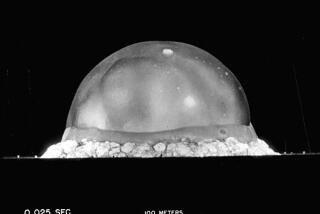Leap Years : What Period Yielded the Most Soaring Advances in History?
- Share via
IN REFLECTING recently on the wonders that came after the graduation of Nardi Reeder Campion’s Wellesley class of 1938 (among them penicillin, panty hose and the Pill), I observed that her list was indeed “a stunning catalogue of the technological changes our generation has exper-ienced.”
Writes Henry L. Scharff of Thousand Oaks: “Modern history was born, as a matter of fact, before 1938. It isn’t hard to see it if one knows a bit of history and a few dates.”
Scharff is unimpressed by the inventions and products that have come since 1938--just a few being television, the jet airliner, credit cards, nuclear weapons, computers, copying machines, lasers, polio shots and the exploration of space.
Those few phenomena are pervasive in our lives today. They have transformed the way we live and the way we communicate. They have altered our hopes and our fears.
Scharff holds that a much greater metamorphosis occurred in the 35 years between 1890 and 1925.
He points out that 1890 was still the horse-and-buggy era, but by 1925 the automobile was ubiquitous. In addition, radio was filling the airwaves, commercial aviation was getting started, and plastics and synthetic fabrics were coming into use.
Scharff fudges a little on television and nuclear weapons. He says that “television was simply awaiting perfection . . . and the world anticipated the freeing of the atom--the theory was known.”
True, television existed in very rudimentary form; inventors had been tinkering with the idea for decades. But it did not become a fact of everyday life until the late 1940s.
As for the world “anticipating the freeing of the atom,” the theory was understood only by physicists, and most of us hadn’t the slightest idea what nuclear fission meant until Aug. 6, 1945, when an atomic bomb was dropped on Hiroshima.
We could just as easily say that the world “anticipated” modern air travel in Leonardo da Vinci’s fanciful sketches for heavier-than-air flying machines, but it wasn’t until 1954 that the first jet airliner made its first commercial flight. It is the jet airliner that has made world travel possible for the millions and brought into being that most boring of human habitats, the airport.
Scharff notes that by 1925 jazz was established as an indigenous American music, and women’s skirts had risen above the knee--”hardly a scientific marvel, but pertinent.”
Scharff argues that we of the present generations could return to 1925 “without feeling we were entering an alien world, but those of 1925 would hardly recognize 1890.”
He has a point there. A world without the automobile, the electric light and the telephone would seem primitive indeed. But if we were transported back to 1925, our most significant losses would be jets, credit cards and the computer. Imagine visiting New York City from Los Angeles without jets and credit cards.
The point is that Mrs. Campion did not mean to imply that the half-century before her graduation had been stagnant; she was merely expressing her astonishment at the number of life-altering inventions that had come in the 50 years after it.
Scharff also tends to dismiss the advances made before 1890: The Industrial Revolution was already more than a century old; the steam locomotive had long been a fact of life; vaccination against smallpox had been perfected; ether was first used as a surgical anesthetic; the cotton gin had made the South a giant of agriculture; the textile mill had industrialized the North; machine harvesters had transformed life on the farm; Edison had patented his incandescent light.
Scharff holds that in following “a false goddess (the one called success?)” since 1938, we have brought upon ourselves moral degeneration, pollution of the planet and a failure to achieve equality. “Mary Wollstonecraft,” he says, “who wrote ‘(A Vindication of) the Rights of Woman,’ would want to weep.
“Is it not possible,” he asks, “that we may be looked back on with undisguised, astonished horror?”
Maybe so. But first we have to get to the next century. With the help of penicillin, panty hose and the Pill, we may make it.






